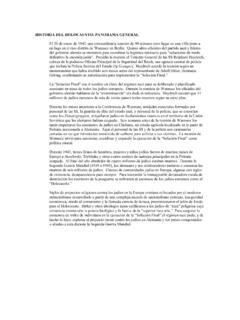Transcription of In the Name of Public Health — Nazi Racial Hygiene
1 N engl j med 351;5 29, 2004 417 PERSPECTIVE In democratic societies, the needs of Public healthsometimes require citizens to make sacrifices forthe greater good, but in Nazi Germany, national orpublic Health Volksgesundheit took completeprecedence over individual Health care. Physiciansand medically trained academics, many of whomwere proponents of Racial Hygiene , or eugenics,legitimized and helped to implement Nazi poli-cies aiming to cleanse German society of peopleviewed as biologic threats to the nation s measures began with the mass ster-ilization of the genetically diseased and endedwith the near-annihilation of European concept of Racial Hygiene had deep roots inGermany.
2 In the late 19th and early 20th centuries,growing numbers of medical and Public Health pro-fessionals decried Germany s declining birth rateand the perceived biologic degeneration of thenation and proposed reforms to improve the quan-tity and quality of the population. Rapid industrial-ization and urbanization had created overcrowdedcities, with attendant conditions of extensive pov-erty and crime; the spread of tuberculosis, syphilis,gonorrhea, and other contagious diseases; andexpanding numbers of persons identified by psy-chiatrists as mentally ill or retarded, who requiredspecial care. These changes coincided with a blos-soming of medical research and the establishmentof dozens of new institutes and laboratories.
3 Break-throughs in bacteriology and the emerging field ofgenetics the publication of August Weismann stheory of immutable germ-plasm in the 1890s andthe rediscovery of Gregor Mendel s laws of he-redity in 1900 seemed to promise biologic ormedical solutions to Germany s problems. Physi-cians and medical researchers began to view them-selves as the guides to a healthy, moral, industriousGermany. 1 The loss of nearly 2 million German men inWorld War I exacerbated fears about populationand spurred new interest in genetics and eugenicsas the path to salvation. Under the postwar WeimarRepublic, two government-sponsored research in-stitutes opened, one focusing on psychiatry, and theother on anthropology, human heredity, and eugen-ics.
4 In the 1920s, many German medical studentstook courses in genetics that integrated the subjectof Racial 1933, eugenics proposals, such as thesterilization of mentally retarded and ill persons,failed to win wide support, but the Nazi revolu-tion, beginning that year with Adolf Hitler s as-sumption of power, upset the status quo. Politicalopposition to eugenics was swept aside, giving wayto an unfettered, coercive, and racist Nazi Mein Kampf, Hitler wrote that the national state.. must see to it that only the healthy beget chil-dren using modern medical means. The Nazidrive to create a healthy German people was tied toultranationalistic and militaristic goals: many morefit workers, farmers, and soldiers were needed forGermany to expand its territory and become a dom-inant world physicians and biologists who support-ed eugenics had to accommodate themselves toNazism s rabid anti-Semitism.
5 But in return for ac-cepting the persecution of Jews as a source of bio-logic degeneration, many in the medical commu-nity welcomed the new emphasis on biology andheredity, increased research funding, and new ca-reer opportunities including openings created eugenics In the Name of Public Health Nazi Racial Hygiene Susan Bachrach, Figure 1. Conducting Twin Studies at the Institute for Anthropology, Human Heredity, and Eugenics in Berlin, February 1928. Geneticist Otmar von Verschuer examined hundreds of pairs of twins to study hereditary links to criminality, mental retardation, tuberculosis, and cancer. From the Archiv zur Geschichte der Max-Planck-Gesellschaft, Berlin.
6 In the Name of Public Health Nazi Racial HygieneCopyright 2004 Massachusetts Medical Society. All rights reserved. n engl j med 351;5 29, 2004 418 PERSPECTIVE by the purge of Jews and leftists from the medicaland Public Health fields. 2 Senior, influential members of the first genera-tion of Racial hygienists collaborated with the Naziregime. Ernst R din, director of the Munich psy-chiatric institute and internationally known for hiswork using genealogical data banks to study theprognosis of psychiatric illnesses, helped to draftthe regime s 1933 compulsory sterilization Fischer, the medically trained director of theBerlin eugenics institute, and Otmar von Verschuer,a geneticist known for his research on twins (seeFigure 1) and the mentor of Dr.
7 Josef Mengele (wholater became notorious for research on twins con-ducted at Auschwitz Birkenau), served as medicaljudges on new Hereditary Health Courts. They andhundreds of other medical and psychiatric special-ists allowed the courts to present evidence sup-porting the state s case for sterilization, such asfamily genealogies tracking purported inheritedtaints and intelligence tests containing education-based 1945, some 400,000 Germans had beenforcibly sterilized. The highly elastic diagnosis of feeblemindedness provided legal grounds inmost cases; the diagnosis of schizophrenia account-ed for the second-largest group.
8 Other illnessescovered under the 1933 law were manic depressivedisorder, genetic epilepsy, Huntington s chorea,genetic blindness, genetic deafness, severe physi-cal deformity, and chronic alcoholism. Severing ofthe fallopian tubes was the typical method of ster-ilizing women, and vasectomy was the commonprocedure for men. As many as 5000 persons diedas a result of the surgery, most of them women. 3 To build Public support for this coercive pro-gram, posters, documentary films, and high-schoolbiology textbooks (see Figure 2) argued the casefor sterilization: an easy surgical procedure, a hu-mane means by which the nation can be protectedfrom boundless misery.
9 The propaganda campaignportrayed its targets as less than fully human. Al-though more strident in tone, its content mirroredhealth pamphlets, displays, and films produced dur-ing the 1920s in other countries where ideas about race betterment had spread, from Great Britain,the United States, Sweden, and Denmark to theSoviet Union, Brazil, and of eugenics in the early 20th cen-tury argued that modern medicine interfered withDarwinian natural selection by keeping the weakalive; that mentally retarded and ill persons werereproducing at a much faster rate than valuable,productive persons; and that costs were escalatingfor maintaining defectives in special homes, hos-pitals, schools, and prisons.
10 4 In the United States,eugenicists helped to pass sterilization laws in manystates, and before 1933, German Racial hygienistscited this experience to buttress their own propos-als for a sterilization law. Between 1907 and 1945,40,000 eugenic sterilization operations were record-ed in the United States, half of them in California,where patients in state mental hospitals were themain targets. Sterilization laws were also introducedin the western Canadian provinces, certain Swisscantons, and Scandinavia. But nowhere did thenumber of sterilizations approach that in Nazi sterilization effort was integrated into Figure 2.











